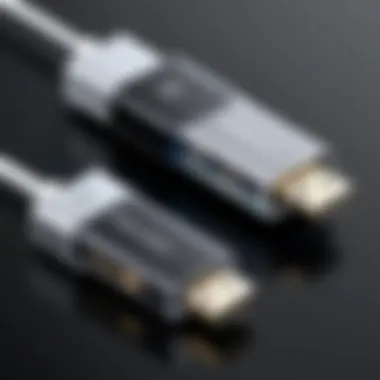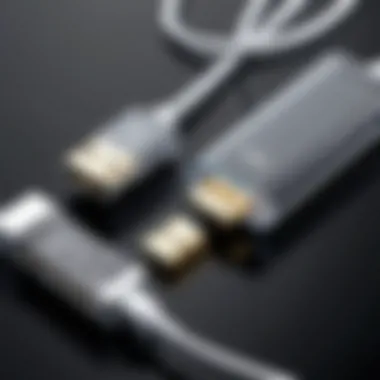Understanding USB to USB-C Dongles in IT


Intro
As technology progresses, the variety of connectivity options increases too. One notable example is the transition from USB to USB-C. The need for USB to USB-C dongles arises from this shift. These devices facilitate communication between the older USB standards and the newer USB-C connections. In this exploration, we will uncover the significance of these dongles, their features, and how they impact daily technology use for IT professionals and tech enthusiasts.
Staying updated on the latest developments is crucial. Users may find themselves needing to connect a variety of devices, encompassing everything from external hard drives to smartphones. When transitioning to USB-C, understanding the specifications of dongles becomes essential. Let’s delve deeper into their features.
Prolusion to USB to USB-C Dongles
In a fast-paced technological landscape, the transition from USB to USB-C is both inevitable and beneficial. Understanding USB to USB-C dongles is critical for anyone involved in information technology. These devices not only bridge the gap between legacy USB connections and newer USB-C ports but also enhance connectivity and functionality for various peripherals.
Definition and Purpose
USB to USB-C dongles serve as converters that allow devices with USB connectors to connect to ports designed for USB-C. These dongles have a clear purpose: they enable communication and power transfer between different types of devices. For instance, one can connect an older laptop with USB-A ports to a new smartphone with a USB-C port. This compatibility is vital in ensuring continuity in device usage, particularly in workplace environments where various device types are common. Dongles can also facilitate faster data transfer and charging, especially when utilizing USB 3.1 or higher, enhancing the overall user experience.
Brief History of USB Standards
The evolution of USB standards reflects the ongoing demand for faster data transfer and greater power delivery. The original USB 1.0 was introduced in 1996, allowing data transfers at rates up to 12 Mbps. With the advent of USB 2.0 in 2000, transfer speeds improved significantly to 480 Mbps, making it the standard for many years. USB 3.0 followed in 2008, boasting speeds of up to 5 Gbps and introduced backward compatibility with previous versions.
The introduction of USB-C in 2014 marked a substantial shift. This standard features a reversible connector, which eliminates the hassle of plugging in devices. USB-C can handle up to 40 Gbps, depending on the implementation, and supports Power Delivery, enabling devices to charge quickly. The ongoing development signifies a trend towards higher performance, addressing the needs of modern technology users.
The history of USB standards is not just a timeline; it represents the adaptibility of technology to meet user demands over time. Understanding this evolution equips IT professionals with knowledge about why USB to USB-C dongles are essential in today's digital ecosystem.
Technical Specifications of USB to USB-C Dongles
The technical specifications of USB to USB-C dongles are fundamental to understanding their functionality and performance. Knowing these specifications helps IT professionals make informed choices, ensuring optimal operation for their devices. Whether it is data transfer rates, compatibility, or power delivery, each specification affects user experience and overall effectiveness in various applications.
USB Versions and Capabilities
USB to USB-C dongles support various USB versions such as USB 2.0, USB 3.0, and USB 3.1. Understanding these versions is crucial as they define the capabilities of the dongles.
- USB 2.0 offers speeds of up to 480 Mbps. It is compatible with a wide range of older devices.
- USB 3.0 can achieve speeds up to 5 Gbps, making it suitable for faster data transfers.
- USB 3.1 further enhances performance with data transfers up to 10 Gbps and improved power delivery.
Compatibility with different USB versions ensures seamless connections between newer USB-C devices and older USB peripherals. IT professionals should assess their needs carefully; for example, a high-speed data transfer may dictate the use of USB 3.0 or above, while basic tasks could be sufficient with USB 2.0.
Power Delivery and Data Transfer Rates
Power delivery (PD) and data transfer rates are critical specifications for any USB to USB-C dongle. Power delivery allows for charging devices at higher wattages, increasing overall efficiency in power management.
Data transfer rates are tied closely to the USB version in use. As noted earlier, USB 2.0 offers modest speeds, while USB 3.0 and USB 3.1 provide significant advantages in speed. Users should be aware that the dongle must support the highest speeds of the connected devices to take full advantage of these capabilities. Below is a summary of common power delivery inputs:
- USB PD 2.0 can deliver up to 100 watts.
- USB PD 3.0 supports faster charging and enhanced energy management.
This makes it possible to efficiently charge laptops, tablets, and smartphones without needing separate chargers, streamlining the user experience.
Physical Design and Port Configurations
The physical design of USB to USB-C dongles often reflects functionality. Most dongles feature simple, compact forms to enhance portability. Their design may include multiple ports, allowing simultaneous connections to various devices.


- Many dongles incorporate a USB-A port alongside USB-C, accommodating both current and legacy devices.
- Some models offer additional features like HDMI connectors or Ethernet ports, which can enhance the dongle's versatility.
Understanding the design and port configurations ensures that users select a dongle that meets their technical requirements, especially when dealing with peripheral devices.
"Selecting the right USB to USB-C dongle involves understanding the specifications and how they align with your devices' capabilities" - IT Professional Insights
The intricacies of technical specifications in USB to USB-C dongles are not just for enthusiasts; they are essential knowledge for any IT professional aiming to stay ahead in technology. Having a firm grasp of these specifications can lead to better choices and improved performance.
Compatibility Considerations
When exploring USB to USB-C dongles, compatibility considerations emerge as a critical focal point. Understanding compatibility is essential not just for ensuring functionality, but also for maximizing utility in various settings. Incompatible hardware can lead to frustration or reduced performance, which can affect productivity.
Device Compatibility - USB Versus USB-C
Compatibility between devices is a core aspect when dealing with USB to USB-C dongles. USB-C has become a standard in modern devices, offering several advantages over older USB types, such as faster charging and better data transfer capabilities.
- USB-A vs. USB-C: USB-A ports, commonly found in legacy devices like older laptops and desktops, differ significantly from the USB-C ports found on newer models. This discrepancy means that devices with only USB-A ports may require a dongle to connect to USB-C peripherals. The physical shape and pin configuration vary, which can directly influence functionality.
- Cross-compatibility: It is vital to note that while USB-C is backward compatible, the reverse is not always true. Older USB devices cannot connect directly to USB-C ports without a dongle. Users must ensure that the dongle they choose can facilitate the connection accurately. Not every dongle will provide the same performance level, so selecting one designed for specific device combinations is prudent.
In summary, careful consideration of device types and their respective ports can prevent connection issues and ensure that the user experience is smooth.
Operating Systems and Driver Requirements
Operating systems play a significant role in the effectiveness of USB to USB-C dongles. Understanding the interaction between dongles and operating systems is critical for optimal performance. Certain dongles may require specific drivers for full functionality, impacting ease of use.
- Driver Dependencies: Some USB to USB-C dongles have proprietary software that must be installed on the system for the dongle to function correctly. When selecting a dongle, it is essential to check whether your operating system supports the driver and to ensure it is up to date.
- Cross-platform compatibility: As users switch between various operating systems like Windows, macOS, or Linux, the dongle’s support for diverse systems becomes increasingly important. While many dongles aim for universal compatibility, this is not guaranteed. Researching compatibility between the dongle and the intended operating system aids in avoiding future compatibility headaches.
Ensuring drivers are up-to-date and compatible across different platforms will yield a better overall experience. This minimizes the risk of malfunctioning devices and maximizes the efficiency of the USB to USB-C dongles.
Use Cases for USB to USB-C Dongles
The relevance of USB to USB-C dongles stretches across various technological landscapes. They serve important roles in connecting devices, enhancing user experience, and improving overall functionality in modern-day tech environments. Understanding the specific uses of these dongles can help IT professionals and tech enthusiasts make better decisions regarding their tech setups.
Connecting Legacy Devices
As technology advances, older devices can struggle to keep up with new standards. A common issue arises when users want to connect legacy devices, like traditional USB peripherals, to the newer USB-C ports found in most modern laptops or smartphones. Here, USB to USB-C dongles offer a practical solution.
By allowing a seamless connection to devices such as printers, keyboards, or external drives that still use USB Type-A connectors, these dongles can effectively extend the lifecycle of existing hardware. This is particularly beneficial in corporate settings where budgets may not allow for immediate upgrades of all equipment. Thus, using a dongle to connect legacy devices can save costs while ensuring productivity isn't hindered.
Enhancing Peripheral Connectivity
In the realm of connectivity, USB to USB-C dongles serve as vital tools. They improve peripheral connectivity by enabling users to connect multiple devices without the need for extra ports. This versatility allows for a smooth integration of various accessories like mice, external storage devices, and audio equipment.
Moreover, many dongles today come with additional features like built-in hubs. These hubs can facilitate multiple connections at one go, which is advantageous for professionals who rely on a variety of devices simultaneously. This simplifies the often cumbersome process of managing multiple connections and enhances the user experience significantly.
Additionally, the ease of using these dongles facilitates faster switching between devices. For instance, switching from a laptop to a tablet can be done in seconds with the right dongle in place, which is appealing for tech-savvy users wanting to maximize their productivity.
Facilitating Charging Solutions
Another critical aspect of USB to USB-C dongles is their ability to support charging solutions. Many users underestimate the power capabilities of these dongles. They not only provide data transfer but can also enable power delivery to different devices. This means that an adapter can allow, for instance, a smartphone to charge from a laptop while transferring files simultaneously.


Charging solutions facilitated by these dongles can cater to various needs depending on the device type. For example, some dongles can support the charging of high-wattage devices like laptops, while others are suitable for smaller gadgets like smartphones or tablets. This flexibility is important as it meets the diverse charging needs in a fast-paced tech environment.
By understanding the use cases of USB to USB-C dongles, IT professionals can optimize their setup for better efficiency and performance while minimizing compatibility issues.
Performance Evaluation
The performance evaluation of USB to USB-C dongles is critical. This section addresses how these devices function under various operational conditions. Understanding the performance metrics can guide consumers and IT professionals in making informed choices. Key areas of focus include data transfer speeds and power delivery quality. Each of these elements has implications for usability and device compatibility.
Benchmarking Data Transfer Speeds
Data transfer speed is a fundamental aspect of USB to USB-C dongles. The technology varies widely, from USB 2.0 up to USB 3.2 and Thunderbolt 3 specifications. Keep in mind that the dongle's speed is influenced by both the cable and the connected devices. Higher versions, like USB 3.1 and 3.2, offer impressive speeds that can reach up to 20 Gbps. This is significant for transferring large files quickly, ideal for users like video editors or data analysts.
It's also important to consider real-world testing. Some dongles perform better than their specifications suggest. Users should check for independent reviews or benchmarks that validate the speed claims of a particular model.
"Benchmarking reveals how dongles hold up against their specifications in practical scenarios."
Quality of Power Delivery
Another essential factor is the quality of power delivery through these dongles. Power delivery means the ability to transmit power alongside data, which is crucial for charging devices. Some dongles support a higher wattage, enabling users to charge laptops while transferring data. For instance, some models provide up to 100 watts, adequate for many laptops and smartphones. Evaluating power delivery performance entails looking at how well a dongle can maintain a stable power flow while in use.
Moreover, compatibility plays an essential role. The dongle must support the charging standards of the device. Users should look for dongles that specifically mention compatibility with their particular devices to avoid power inconsistencies. Poor power quality can lead to overheating or unreliable connections, undermining the utility of the dongle in everyday tasks.
Market Trends and Consumer Preferences
The landscape of USB to USB-C dongles is shifting rapidly. Understanding market trends and consumer preferences is vital for IT professionals and tech enthusiasts alike. This knowledge facilitates informed decisions regarding product selection, enhances awareness of innovations, and anticipates future demands. The USB type has transcended basic functionality, becoming integral in daily use across various devices.
Emerging Brands and Innovations
In recent years, several new brands have emerged in the USB to USB-C dongle market. These brands focus on innovation, quality, and design. They aim to differentiate themselves from established names. For instance, companies like Anker and Aukey have shown a commitment to developing dongles that support higher data transfer rates and enhanced durability.
Innovation extends beyond mere data transfer. Features such as built-in power delivery and versatile port configurations are increasingly common. Consumers now look for dongles that not only connect devices but also streamline their workspace. With rising competition, prices have also become more competitive, presenting buyers with a broader range of options.
Consumer Trust and Brand Loyalty
Consumer trust plays a significant role in the market for USB to USB-C dongles. Shoppers often rely on brand reputation when selecting these devices. Reviews and user feedback are critical factors for many. Brands that consistently deliver quality products naturally build a loyal customer base. For instance, companies that offer strong warranties and customer support often enjoy increased brand loyalty.
Furthermore, social proof impacts consumer behavior. Many tech enthusiasts participate in online forums like Reddit or Facebook groups. These platforms provide avenues for sharing experiences and recommendations. As a result, brands that engage well with their customers online tend to receive more trust and interest.
"Quality and reliability are key indicators for consumers when choosing a USB to USB-C dongle."
Overall, market trends point towards a greater emphasis on innovative features and reliability. This creates a dynamic environment where consumer preferences can shape the future of USB to USB-C technology. With ongoing advancements, buyers are set to enjoy a more robust and engaging experience.
Challenges and Limitations
Understanding the challenges and limitations associated with USB to USB-C dongles is essential for IT professionals and tech enthusiasts. These devices, while highly useful, are not without their drawbacks. Their integration into various ecosystems, as well as their pricing dynamics, raise several concerns that need careful consideration. Addressing these challenges can lead to informed decisions when selecting the right dongle for specific needs.
Common Issues with Compatibility


One of the main challenges of USB to USB-C dongles is compatibility. Various factors influence how well these devices function across different platforms and devices. Not all USB-C ports are created equal; some support only data transfer while others allow for video output and charging. It is crucial to check whether both the dongle and the connected device meet the required specifications.
- Device Diversity: Different brands and devices may have varying implementations of USB-C standards. A dongle that works with one device might not work with another, even if both are USB-C compatible.
- Operating System Variability: Some dongles may require specific drivers that are compatible with certain operating systems. Compatibility with Windows, MacOS, or Linux can vary, making it necessary to validate functionality based on the OS in use.
- Protocol Conflicts: USB-C supports multiple protocols including Thunderbolt. A dongle may not support all features of USB-C, which can limit functions like fast charging or high-resolution video output.
"Understanding the compatibility framework for USB to USB-C dongles helps avoid frustration during connections."
Cost Considerations in High-End Models
When it comes to high-end USB to USB-C dongles, cost is another significant consideration. The market offers a range of options, from basic models to more advanced, multifunctional dongles. Assessing the cost versus benefits is vital to determine if a high-end model justifies its price tag.
- Build Quality: Costlier dongles often feature more robust build quality, which may lead to increased durability. Cheaper models might use lower-quality materials, risking breakage over time.
- Enhanced Features: Higher price points frequently translate into added features such as faster data transfer rates, Power Delivery capabilities, and compatibility with multiple device formats. Users should evaluate whether these enhancements align with their usage needs.
- Warranty and Support: Premium dongles may come with better customer support and warranty options. This can be particularly valuable for businesses relying on these devices for day-to-day operations.
Future of USB to USB-C Technology
The evolution of USB to USB-C technology holds immense significance in today’s high-paced tech environment. The acceleration of technological advancements emphasizes the need for efficient and adaptable accessories. Dongles, particularly USB to USB-C, serve as a bridge between devices that would otherwise be incompatible. Therefore, examining the future of this technology is critical for IT professionals and tech enthusiasts alike.
As devices continue to advance, their reliance on higher data transfer speeds and improved charging capabilities becomes salient. USB to USB-C dongles are positioned to meet these requirements. They not only cater to current needs but also align with anticipated future capabilities, ensuring longevity and versatility in the tech ecosystem.
Predictions on Technological Evolution
The future of USB to USB-C technology will likely see several noteworthy developments. First, the increase in production efficiency may lead to lower costs for these dongles. This is particularly relevant as consumer electronics continuously integrate USB-C as a standard. Consequently, demand will surge, driving manufacturers to innovate and broaden their product lines.
Moreover, improvements in data transfer rates up to 20 Gbps, driven by USB 3.2 technology, are expected. As manufacturers adopt these enhanced standards, the compatibility and reliability of dongles will improve dramatically. In turn, this will establish a robust foundation to support emerging technologies such as virtual reality and 8K video streaming.
The adaptability of USB-C will also lead to an increased variety of dongles on the market, catering to diverse devices. From smartphones to laptops, a single type of dongle can potentially service multiple devices, reducing the need for various adapters. This is particularly attractive in professional environments where efficiency and organization are paramount.
Potential for Standardization
Standardization of USB to USB-C technology presents several advantages for consumers and manufacturers. Firstly, it leads to a cohesive ecosystem where devices communicate seamlessly. This is beneficial for IT professionals who manage equipment in dynamic settings; a standardized system minimizes complexity and troubleshooting time.
Another critical aspect of standardization is the assurance of compatibility among devices. As USB-C becomes a universal standard, the variability in performance can diminish. This mitigates issues related to power delivery and data transmission that arise from the use of various dongles.
Developing guidelines from governing bodies could further optimize USB to USB-C technology. Such protocols would ensure consistent quality among products, which ultimately fosters consumer confidence. This is significant for tech enthusiasts who seek reliable products in an oversaturated market.
Finale
The conclusion of this article is critical in reinforcing the importance of USB to USB-C dongles in today’s technological landscape. As a bridge connecting the old and new technologies, these devices ensure that users can maintain productivity without the need for constant updates to their hardware.
In this fast-paced world, where technology evolves rapidly, acknowledging the relevance of these dongles is vital for both individuals and organizations. Their value lies in several key elements:
- Cost-effectiveness: Users can extend the life of existing equipment without heavy investment.
- Adaptability: These dongles connect diverse devices, establishing compatibility between USB and USB-C formats.
- User convenience: They simplify connectivity issues, enhancing the overall user experience.
- Future-proofing: As USB-C becomes increasingly common, a reliable dongle supports a seamless transition for users.
By understanding the nuances of USB to USB-C dongles, IT professionals can make more informed choices, avoiding costly mistakes while navigating their tech ecosystems. Moreover, grasping the technical specifications and potential limitations provides deeper insight into selecting the right device that meets specific needs.
Summary of Key Points
- Dongle Significance: Clarified their role in bridging USB and USB-C technologies.
- Technical Overview: Discussed specifications, performance metrics, and compatibility factors.
- Use Cases: Explained practical applications in real-world scenarios.
- Market Trends: Analyzed emerging trends and brand innovations.
- Challenges: Highlighted common issues and considerations in choosing dongles.
- Future Predictions: Speculated on technological advancements and the potential for standardization.
Final Thoughts on USB to USB-C Dongles
As we move towards a more interconnected future, embracing the capabilities of USB to USB-C dongles becomes increasingly pertinent. Their designs, functionality, and applicability can vastly influence one’s operational efficiency. Therefore, knowledge of their attributes and the landscape of available products is essential for making sound decisions in technology investments.
"The right dongle can be the difference between connectivity and frustration in today's tech-driven environment."
Many resources are available for a deeper dive into this subject, such as Wikipedia for historical context and device specifications, and community discussions on platforms like Reddit can provide firsthand user experiences. With the right information, one can navigate through the complexities of connectivity with confidence.



